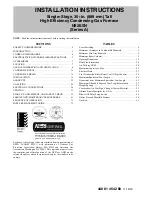
4
Rinnai Corporation EX38CT Manual
Installation Instructi
o
ns (for the licensed professional)
State Regulations
NOTICE BEFORE INSTALLATION: Rinnai direct
-
vent appliance must be installed by a state qualified or licensed contractor and
a properly trained Rinnai Installer. If you are not properly trained, you must not install this unit.
IMPORTANT:
In the State of Massachusetts (248 CMR 4.00 & 5.00)
For all side wall horizontally vented gas fueled equipment installed in every dwelling, building or structure used in whole or in
part for residential purposes, including those owned or operated by the Commonwealth and where the side wall exhaust vent
termination is less than seven (7) feet above finished grade in the area of the venting, including but not limited to decks and
porches, the following requirements shall be satisfied:
1.
INSTALLATION OF CARBON MONOXIDE DETECTORS. At the time of installation of the side wall horizontal vented gas
fueled equipment, the installing plumber or gasfitter shall observe that a hard wired carbon monoxide detector with an alarm
and battery back
-
up is installed on the floor level where the gas equipment is to be installed. In addition, the installing
plumber or gasfitter shall observe that a battery operated or hard wired carbon monoxide detector with an alarm is installed
on each additional level of the dwelling, building or structure served by the side wall horizontal vented gas fueled equipment.
It shall be the responsibility of the property owner to secure the services of qualified licensed professionals for the
installation of hard wired carbon monoxide detectors
a.
In the event that the side wall horizontally vented gas fueled equipment is installed in a crawl space or an attic, the hard
wired carbon monoxide detector with alarm and battery back
-
up may be installed on the next adjacent floor level.
b.
In the event that the requirements of this subdivision can not be met at the time of completion of installation, the owner
shall have a period of thirty (30) days to comply with the above requirements; provided, however, that during said thirty
(30) day period, a battery operated carbon monoxide detector with an alarm shall be installed.
2.
APPROVED CARBON MONOXIDE DETECTORS. Each carbon monoxide detector as required in accordance with the
above provisions shall comply with NFPA 720 and be ANSI/UL 2034 listed and IAS certified.
3.
SIGNAGE. A metal or plastic identification plate shall be permanently mounted to the exterior of the building at a minimum
height of eight (8) feet above grade directly in line with the exhaust vent terminal for the horizontally vented gas fueled
heating appliance or equipment. The sign shall read, in print size no less than one
-
half (1/2) inch in size,
"GAS VENT
DIRECTLY BELOW. KEEP CLEAR OF ALL OBSTRUCTIONS".
4.
INSPECTION. The state or local gas inspector of the side wall horizontally vented gas fueled equipment shall not approve
the installation unless, upon inspection, the inspector observes carbon monoxide detectors and signage installed in
accordance with the provisions of 248 CMR 5.08(2)(a)1 through 4.
When an existing Category I heater is removed or replaced, the original venting system may no longer be sized to properly vent
the attached appliances. Instructions shall also indicate effects of an improperly sized venting system (formation of condensate,
leakage, spillage, etc.) and shall specify the following test procedure.
WARNING: CARBON MONOXIDE POISONING HAZARD
Failure to follow the steps outlined below for each appliance connected to the venting system being placed into operation could
result in carbon monoxide poisoning or death.
The following steps shall be followed for each appliance connected to the venting system being placed into operation, while all
other appliances connected to the venting system are not in operation:
1.
Seal any unused openings in the venting system.
2.
Inspect the venting system for proper size and horizontal pitch, as required in the
National Fuel Gas Code
, ANSI Z223.1/
NFPA 54 or the
Natural Gas and Propane Installation Code
, CSA B149.1 and these instructions. Determine that there is no
blockage or restriction, leakage, corrosion and other deficiencies which could cause an unsafe condition.
3.
As far as practical, close all building doors and windows and all doors between the space in which the appliance(s)
connected to the venting system are located and other spaces of the building.
4.
Close fireplace dampers.
5.
Turn on clothes dryers and any appliance not connected to the venting system. Turn on any exhaust fans, such as range
hoods and bathroom exhausts, so they are operating at maximum speed. Do not operate a summer exhaust fan.
6.
Follow the lighting instructions. Place the appliance being inspected into operation. Adjust the thermostat so appliance is
operating continuously.
7.
Test for spillage from draft hood equipped appliances at the draft hood relief opening after 5 minutes of main burner
operation. Use the flame of a match or candle.
8.
If improper venting is observed during any of the above tests, the venting system must be corrected in accordance with the
National Fuel Gas Code
, ANSI Z223.1/NFPA 54 and/or
Natural Gas and Propane Installation Code
, CSA B149.1.
9.
After it has been determined that each appliance connected to the venting system properly vents when tested as outlined
above, return doors, windows, exhaust fans, fireplace dampers and any other gas
-
fired burning appliance to their previous
conditions of use.
WARNING
Содержание EX38CT RHFE-1005FTA2
Страница 35: ...Rinnai Corporation EX38CT Manual 35 Cut Away Diagram ...
Страница 39: ...Rinnai Corporation EX38CT Manual 39 Parts List Liste de Pièces ...
Страница 40: ...40 Rinnai Corporation EX38CT Manual Parts List Liste de Pièces ...
Страница 41: ...Rinnai Corporation EX38CT Manual 41 Parts List Liste de Pièces ...
Страница 42: ...42 Rinnai Corporation EX38CT Manual Parts List Liste de Pièces ...
Страница 48: ...48 Rinnai Corporation EX38CT Manual NOTES ...
Страница 88: ...107559 RHF1005 1254X02 00 200000074 02 5 2018 ...





































